chapt01.docx
《chapt01.docx》由会员分享,可在线阅读,更多相关《chapt01.docx(29页珍藏版)》请在冰豆网上搜索。

chapt01
PART1:
INTRODUCTION
CHAPTER1-MANAGERSANDMANAGEMENT
LEARNINGOUTCOMES
Afterreadingthischapterstudentsshouldbeableto:
1.Describethedifferencebetweenmanagersandoperativeemployees.
2.Explainwhatismeantbythetermmanagement.
3.Differentiatebetweenefficiencyandeffectiveness.
4.Describethefourprimaryprocessesofmanagement.
5.Classifythethreelevelsofmanagers,andidentifytheprimaryresponsibilityofeachgroup.
6.Summarizetheessentialrolesperformedbymanagers.
7.Discusswhetherthemanager'sjobisgeneric.
8.Describethefourgeneralskillsnecessaryforbecomingasuccessfulmanager.
9.Describethevalueofstudyingmanagement.
10.Identifytherelevanceofpopularhumanitiesandsocialsciencecoursestomanagementpractices.
OpeningVignette
SUMMARY
ManagerWiinWu.
Whatdistinguishesthoseorganizationsthatsucceedfromthosethatdon'taregoodmanagers.Managersaccomplishgoalsthroughandwiththeeffortsofothers.
EducatedatMITandStanforduniversities,WiinbeganhiscareeratIntel.Hehadavisionofhowtomakebettercomputerchipsandmadeitarealityin1989whenhefoundedMacronixInternational,Ltd.inTaiwan.HWualsorealizedthatnoorganizationcouldremaincomplacentandthatlongtermsuccesscamefromidentifyingopportunitiesandstakingoutagrowthplan.Soealsocreatedallianceswithothercompaniesalsoinvestingheavilyinresearchanddevelopment.Wiinneveroverlookstheroleofthehumanfactorinhisbusiness,constantlyseekingtore-createtheorganization,fosteringaworkenvironmentthatpromotesenthusiasm.HiseffortshaveprovensuccessfulforMacronixInternational;companysalesbrokethrough$320millionin1998,anditsshareoftheAsianmicrochipmarkethasnearlydoubledfrom2.8to5.4percent,andhasearnedtherecenthonorofbeingchosenoneofTaiwan'sthrivinghigh-techcompanies.
WiinWuprovidesagoodexampleofwhatasuccessfulmanagerdoes.Theymanagelargecorporations,smallbusinesses,etc.,whileholdingpositionsatthetop,inthemiddle,andonthelineoverseeingemployees,anddoingtheirworkineverycountryontheglobe.
Teachingtips
1.Makecontactwith3-5localcompaniesorCEOsthroughthechamberofcommerce,Kiwanisclub,etc.
2.Choose3-5volunteersor3-5teamstovisittheselocalcompaniesandconductbrief30-minuteinterviewswiththeCEOs.
3.Asaclass,usingthischapter,brainstormwhatquestions,5-7atthemost,eachteamorinterviewershouldask.
4.Havetheinterviewersreportbacktoclasswhattheylearned.
5.Asaclass,discusshowtheirdiscoveriesfitordonotfitcoursecontent.
I.WHOAREMANAGERS,ANDWHEREDOTHEYWORK?
A.Introduction
1.Managersworkinanorganization.
2.Anorganizationisasystematicarrangementofpeoplebroughttogethertoaccomplishsomespecificpurpose.
a)Yourcollegeoruniversityisanorganization.
B.WhatThreeCommonCharacteristicsDoAllOrganizationsShare?
1.Everyorganizationhasapurposeandismadeupofpeoplewhoaregroupedinsomefashion.
a)SeeExhibit1-1.
b)Thisdistinctpurposeistypicallyexpressedintermsofagoalorsetofgoals.
2.Second,purposesorgoalscanbeachievedonlythroughpeople.
3.Third,allorganizationsdevelopasystematicstructurethatdefinesandlimitsthebehavioroftheirmembers.
a)Developingstructuremayincludecreatingrulesandregulations,controlofmembers,etc.
4.Organization--hasadistinctpurpose,haspeopleormembers,andhasasystematicstructure.
C.HowAreManagersDifferentfromOperativeEmployees?
1.Organizationalmembersfitintotwocategories:
operativesandmanagers.
a)Operativesworkdirectlyonajobandhavenooversightresponsibilityofothers.
b)Managersdirecttheactivitiesofotherpeopleintheorganization.
(1)Customarilyclassifiedastop,middle,orfirst-line,theysupervisebothoperativeemployeesandlower-levelmanagers.
(2)SeeExhibit1-2.
(3)Somemanagersalsohaveoperativeresponsibilitiesthemselves.
2.Thedistinction,managershaveemployeeswhoreportdirectlytothem.
D.WhatTitlesDoManagersHaveinOrganizations?
1.First-linemanagersareusuallycalledsupervisors.
a)Theyareresponsiblefordirectingtheday-to-dayactivitiesofoperativeemployees.
b)Inyourcollege,theDepartmentChairwouldbeafirst-linesupervisor.
2.Middlemanagers--managementbetweenthefirst-linesupervisorandtopmanagement.
a)Theymanageothermanagersandpossiblysomeoperativeemployees.
b)Theyareresponsiblefortranslatingthegoalssetbytopmanagementintospecificdetails.
3.Topmanagers,likeWiinWu,areresponsibleformakingdecisionsaboutthedirectionoftheorganizationandestablishingpoliciesthataffectallorganizationalmembers.
TeachingNotes_______________________________________________________________________
_____________________________________________________________________________________
_____________________________________________________________________________________
_____________________________________________________________________________________
_____________________________________________________________________________________
II.WHATISMANAGEMENT,ANDWHATDOMANAGERSDO?
A.HowDoWeDefineManagement?
1.Managers,regardlessoftitle,shareseveralcommonelements.
2.Management--theprocessofgettingthingsdone,effectivelyandefficiently,throughandwithotherpeople.
a)Processinthedefinitionrepresentstheprimaryactivitiesmanagersperform.
3.Effectivenessandefficiencydealwithwhatwearedoingandhowwearedoingit.
a)Efficiency--doingthetaskrightandtotherelationshipbetweeninputsandoutputs.
b)Effectiveness--doingtherighttask,thattranslatesintogoalattainment
c)SeeExhibit1-3.
4.Efficiencyandeffectivenessareinterrelated.
a)It'seasiertobeeffectiveifoneignoresefficiency.
b)Goodmanagementattainsgoals(effectiveness)anddoingsoasefficientlyaspossible.
c)Organizationscanbeefficientandyetnotbeeffective.
d)Highefficiencyisassociatedmoretypicallywithhigheffectiveness.
5.Poormanagementismostoftenduetobothinefficiencyandineffectiveness.
B.WhatAretheManagementProcesses?
1.HenriFayoldefinedthemanagementprocessintermsoffivemanagementfunctions.
a)Theyplan,organize,command,coordinate,andcontrol.
b)Inthemid-1950s,twoprofessorsusedthetermsplanning,organizing,staffing,directing,andcontrollingastheframeworkforathemostwidelysoldmanagementtextbook.
2.Themostpopulartextbooksnowcondensetothebasicfour:
planning,organizing,leading,andcontrolling.
a)SeeExhibit1-4.
b)Theseprocessesareinterrelatedandinterdependent.
3.Planningencompassesdefininganorganization'sgoals,establishinganoverallstrategyforachievingthosegoals,anddevelopingcomprehensiveplanstointegrateandcoordinate.
a)Settinggoalscreatesaproperfocus.
4.Organizing--determiningwhattasksaretobedone,whoistodothem,howthetasksaretobegrouped,whoreportstowhom,andwheredecisionsaretobemade.
5.Directingandcoordinatingpeopleistheleadingcomponentofmanagement.
a)Managersmotivateemployees,directtheactivitiesofothers,selectthemosteffectivecommunicationchannel,orresolveconflictsamongmembers.
6.Controlling.
a)Toensurethatthingsaregoingastheyshould,amanagermustmonitorperformance.
b)Actualperformancemustbecomparedwiththepreviouslysetgoals.
c)Anysignificantdeviationsmustbeaddressed.
d)Themonitoring,comparing,andcorrectingisthecontrollingprocess.
7.Theprocessapproachisclearandsimplybutmaynotaccuratelydescribewhatmanagersdo.
a)Fayol'soriginalapplicationsrepresentedobservationsofhisexperience.
8.HenryMintzbergprovidedfreshinsightonthemanager'sjob.
TeachingNotes_______________________________________________________________________
_____________________________________________________________________________________
_____________________________________________________________________________________
_____________________________________________________________________________________
_____________________________________________________________________________________
_____________________________________________________________________________________
_____________________________________________________________________________________
_____________________________________________________________________________________
C.WhatAreManagementRoles?
1.HenryMintzbergundertookacarefulstudyoffivechiefexecutivesatwork.
a)Managersengagedinalargenumberofvaried,unpatterned,andshort-durationactivities.
b)Therewaslittletimeforreflectivethinking.
c)Halfofthesemanagers'activitieslastedlessthannineminutes.
2.Hiscategorizationscheme--Mintzberg'smanagerialroles.
3.Mintzbergconcludedthatmanagersperformtendifferentbuthighlyinterrelatedroles.
a)ThesetenrolesareshowninExhibit1-5.
b)Theyaregroupedunderthreeprimaryheadings.
(1)Interpersonalrelationships.
(2)Thetransferofinformation.
(3)Decisionmaking.
D.IstheManager'sJobUniversal?
1.Levelintheorganization.
a)Thedifferencesareofdegreeandemphasisbutnotofactivity.
b)Asmanagersmoveup,theydomoreplanningandlessdirectoverseeingofothers.
(1)SeeExhibit1-6.
c)Theamountoftimemanagersgivetoeachactivityisnotnecessarilyconstant.
d)Thecontentofthemanagerialactivitieschangeswiththemanager'slevel.
(1)Topmanagersareconcernedwithdesigningtheoverallorganization'sstructure.
(2)Lower-levelmanage